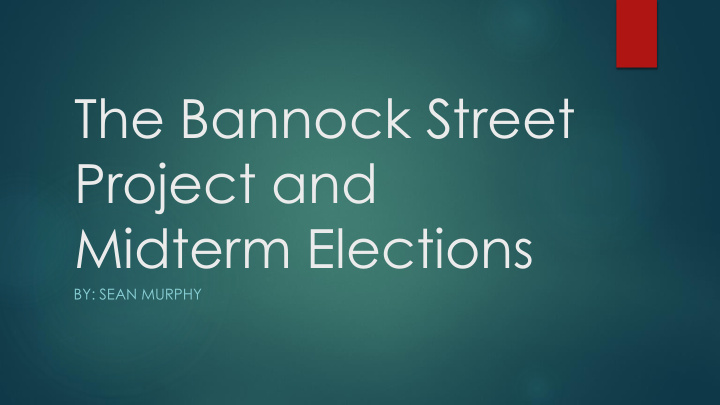



The Bannock Street Project and Midterm Elections BY: SEAN MURPHY
The Midterm Dilemna President's Party loses Congressional seats in midterm elections Lower Voter Turnout
The Bannock Street Project Attempt to create a turnout similar to Obama 2008 56.8% voter turnout 1. 13% African American 2. 18% Youth Vote 3. 10 Battleground States Reaction to 2010 37.8% voter turnout 1. 69 Congressional Seats 2.
The Execution Increased Voter Contact by 68% Registered 2.3 Million Voters Averaged 76,000 more votes
The Result Alaska – R= 49% - D= 45% Arkansas - R= 57% - D= 39% Georgia – R= 53% - D= 45% Iowa – R= 52% - D= 44% Kentucky – R= 56% - D= 41% Louisiana* – R=56% - D= 44% Michigan – R= 41% - D= 55% Montana – R= 58% - D= 40% North Carolina – R= 49% - D= 47% West Virginia - R= 62% - D= 34%
Surge and Decline Theory Angus Campbell (James Campbell) High Stimulus vs. Low Stimulus Core Voters vs. Peripheral Voters Partisanship
The Negative Voting Theory Samuel Kernell (Atkeson & Partin) Presidential approval declines by midterm Referendum on the President Partisan defectors Independent Voters
Initial Evidence Turnout Approval Barack Obama Barack Obama 2014 – 36.3% 2014 – 42% 1. 1. +/- 1.5% +/- 3% 2010 – 37.8% 2010 – 45% 2. 2. George W. Bush George W. Bush 2006 – 37.1% 2006 – 37% 1. 1. +/- 26% +/-.1% 2002 – 37% 2002 – 63% 2. 2. Bill Clinton Bill Clinton 1998 – 36.4% 1998 – 65% 1. 1. +/- 2.4% +/- 17% 1994 – 38.8% 1994 – 48% 2. 2.
My Hypothesis Negative Voting was a driving force for voters in 2014 The Bannock Street Project focused its resources on the wrong strategy.
Negative Voting Data
Negative Voting Continued
Surge and Decline Data
In Conclusion Not enough data to be conclusive Indications towards Negative Voting Theory If this was a result of Negative Voting, the Bannock Street Project needed a different strategy
Recommend
More recommend